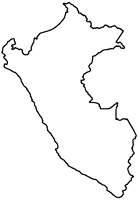
|
The Society of Folk Dance Historians (SFDH) Peru
[
Home |
About |
Encyclopedia | CLICK IMAGE TO ENLARGE |

|
BACKGROUND
Information: A country.
Peru, officially the Republic of Peru, is a country in western South America bordered in the north by Ecuador and Colombia, in the east by Brazil, in the southeast by Bolivia, in the south by Chile, and in the west by the Pacific Ocean.
Peruvian territory was home to several ancient cultures. Ranging from the Norte Chico civilization starting in 3500 BCE, the oldest civilization in the Americas and one of the five cradles of civilization, to the Inca Empire, the largest state in pre-Columbian America, the territory now including Peru has one of the longest histories of civilization of any country, tracing its heritage back to the 4th millennia BCE.
The Spanish Empire conquered the region in the 16th century and established a viceroyalty that encompassed most of its South American territories, with its capital in Lima. Peru formally proclaimed independence in 1821.
The Cupisnique culture which flourished from around 1000 to 200 BCE along what is now Peru's Pacific Coast was an example of early pre-Incan culture. In the 15th century, the Incas emerged as a powerful state which, in the span of a century, formed the largest empire in pre-Columbian America with their capital in Cusco. From 1438 to 1533, the Incas used a variety of methods, from conquest to peaceful assimilation, to incorporate a large portion of western South America, centered on the Andean mountain ranges, from southern Colombia to northern Chile, between the Pacific Ocean in the west and the Amazon rainforest in the east. The official language of the empire was Quechua, although hundreds of local languages and dialects were spoken. The Inca referred to their empire as Tawantinsuyu which can be translated as "The Four Regions" or "The Four United Provinces."
The indigenous population dramatically collapsed due to exploitation, socioeconomic change and epidemic diseases introduced by the Spanish. The expansion of a colonial administrative apparatus and bureaucracy paralleled the economic reorganization. With the conquest started the spread of Christianity in South America; most people were forcefully converted to Catholicism, taking only a generation to convert the population. They built churches in every city and replaced some of the Inca temples with churches, such as the Coricancha in the city of Cusco. The church employed the Inquisition, making use of torture to ensure that newly converted Catholics did not stray to other religions or beliefs.
Peru is a unitary presidential representative democratic republic with a multi-party system. The Peruvian government is directly elected, and voting is compulsory for all citizens aged 18 to 70.
National Dance: Marinera
Language: Spanish
Religion: Roman Catholicism
DOCUMENTS
- Americas, a region.
- Beware of Gift Giving Customs in Foreign Lands, a list.
- Latin America, a region.
- National Geographic Magazine Folklore Index 1914-1997, a list.
- Peruvian Dance and Culture, an article.
- South America, a continent.
This page © 2018 by Ron Houston.
Please do not copy any part of this page without including this copyright notice.
Please do not copy small portions out of context.
Please do not copy large portions without permission from Ron Houston.